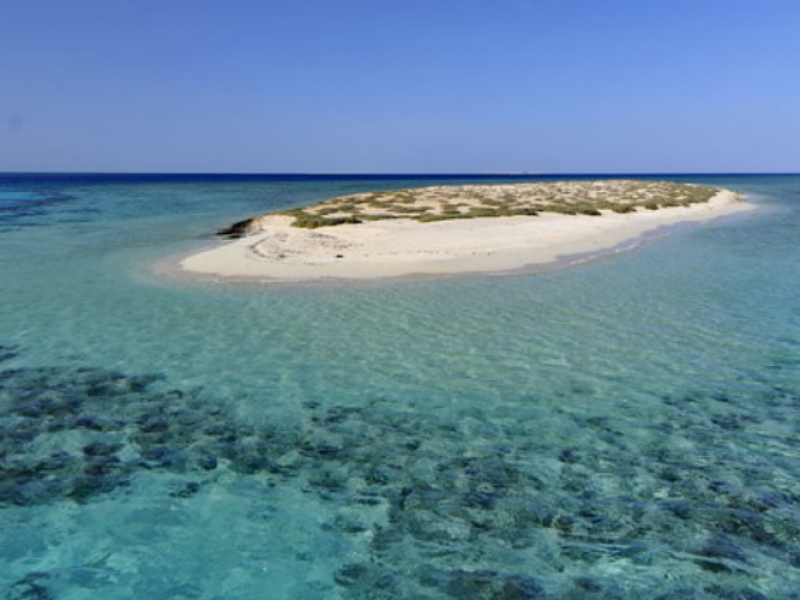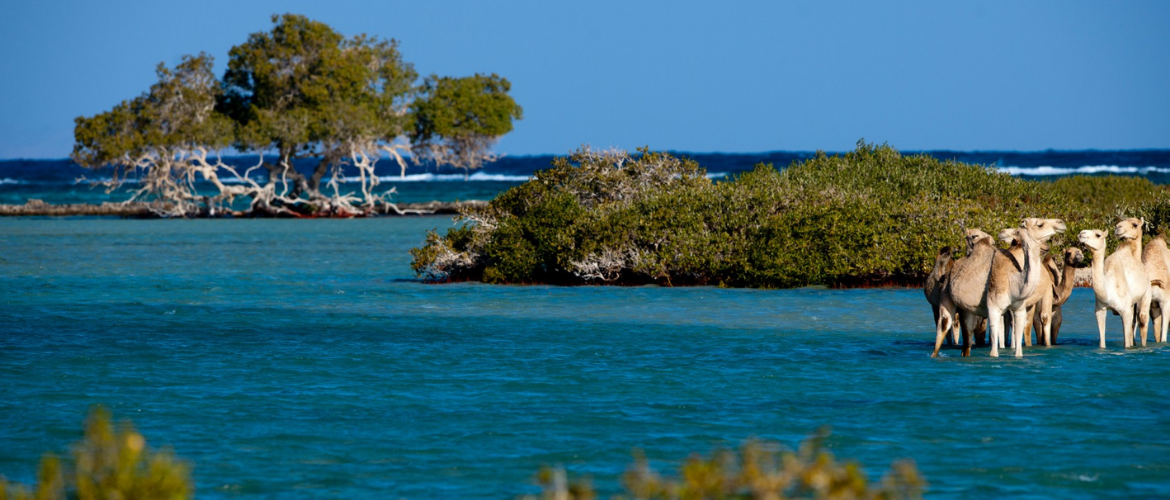Wadi el Gemal National Park
GENERAL INFO
The area of Wadi el Gemal, whose name means « Valley of camels », was declared National Park in 2003, in order to preserve an extraordinary terrestrial and marine ecosystem, which is incredibly rich from a landscape, botanical, and wildlife viewpoint, and includes numerous archeological sites of great importance. Among these mountains, the famous emerald mines of the Pharaohs are hidden: the oldest in the world, and the only ones known before the New World was discovered. The Park of Wadi Gemal, still relatively unknown and rarely visited, is home to an important community of Ababda Beduins, who are trying preserve their ancient traditions. Inside the Park we find a variety of sites of great tourist interest, as well as sandy beaches, and shorelines fringed by coral reefs among the most beautiful and unspoiled in Egypt.
AREA
The Park of Wadi el Gemal is the only one in Egypt, besides the one of Ras Mohamed, which includes a terrestrial area that extends over a surface of 4770 Sq Km, and a marine area that develops over another 2000 Sq Km, extending over 120 Km of shoreline, often bordered by vast mangrove areas.
MAIN ATTRACTIONS
The Beaches
The coasts of the Park of Wadi el Gemal are flanked in many spots by breath-taking beaches of very fine sand that gently sink in the blue waters of the sea. One of the most popular beaches, both for its beauty and ease of access, is the one of the Bay of Hankorab, located less than twenty kilometers South of the main hotels in the area. A lovely coral reef marks off the Northern side of the beach, allowing people to snorkel or dive (this site is especially suitable for beginners since it is protected from waves and currents). The coral reef is rich in madrepores, among which a multitude of reef fish hover around, such as the red Anthias, as well as Butterfly fish, Parrotfish,and Damselfish. The beach is equipped with beach umbrellas, toilets, and a small café: a pleasant walk allows one to reach the nearby lighthouse of Ras Hankorab. More to the South, at Abu Ghosun and Qulan, there are two more amazing beaches, less frequented than the previous one.In Qulan, there is one of the most beautiful lagoons of the Red Sea, famous for its turquoise-blue waters, while all-around one can admire large mangroves. A small restaurant, a café, and a center for the sale of local handicrafts managed by Beduins are another attraction of this wonderful site.Finally, for athletes and kitesurf enthusiasts, there is the long beach of the Kite Village, which is a center especially dedicated to those who practice this sport. Even more to the South, the big and lovely beach of Wadi Lahami is home to a huge forest of mangroves, and is equipped with a small ecolodge and a dive center.

The Dive Sites
Within the Park’s territory, there are around thirty interesting dive sites, suitable for divers of any level. Most of them can only be reached by boat, but some can also be reached from the beach, such as Hankorab and Abu Ghosun. When diving this last site, divers can admire the wreck of the Hamada, a cargo that sunk here in 1993. Among the most notable sites that can be reached by boat are the ones around the Island of Wadi el Gemal, and the Island of Siyul, also called « Island of the birds », since it has been colonized by eight species of birds that nest here. Here divers can admire huge table corals, teeming with marine life. More to the South, the famous reef of Sataya, nicknamed « Dolphins House », where in the middle of a large lagoon protected by waves and currents lives a colony of spinner dolphins (Stenella longirostris), which can be easily seen while snorkeling.



Good post. I’m dealing with a few of these issues as well..
Hi there, I enjoy reading all of your article. I like to write a little comment to support you.
Magnificent goods from you, man. I’ve understand your stuff previous to and you’re just too fantastic. I really like what you’ve acquired here, really like what you’re stating and the way in which you say it. You make it entertaining and you still take care of to keep it sensible. I cant wait to read far more from you. This is actually a great site.
This post is actually a good one it helps new net viewers, who are wishing for blogging.
Hi there! I realize this is somewhat off-topic but I had to ask. Does building a well-established blog like yours take a lot of work? I’m completely new to writing a blog but I do write in my diary daily. I’d like to start a blog so I can share my own experience and thoughts online. Please let me know if you have any suggestions or tips for new aspiring bloggers. Appreciate it!
Fine way of explaining, and nice post to get data concerning my presentation subject matter, which i am going to convey in college.
Thanks for your marvelous posting! I seriously enjoyed reading it, you could be a great author.I will always bookmark your blog and will often come back sometime soon. I want to encourage you to continue your great writing, have a nice holiday weekend!
Thank you, I have recently been searching for information approximately this topic for ages and yours is the best I have found out so far. However, what about the conclusion? Are you positive concerning the source?
I got this website from my pal who informed me concerning this website and now this time I am visiting this web site and reading very informative posts at this place.
Useful info. Fortunate me I found your web site accidentally, and I am stunned why this coincidence did not happened in advance! I bookmarked it.
hi!,I love your writing so much! proportion we communicate more approximately your post on AOL? I need an expert in this space to solve my problem. May be that is you! Looking forward to peer you.
Very nice article, just what I wanted to find.
Someone necessarily lend a hand to make significantly articles I would state. This is the first time I frequented your web page and to this point? I amazed with the research you made to create this actual post amazing. Wonderful activity!
I pay a visit daily some sites and blogs to read articles or reviews, but this weblog gives quality based posts.
Хотите заказать механизированную штукатурку стен в Москве, но не знаете, где искать надежного подрядчика? Обратитесь к нам на сайт mehanizirovannaya-shtukaturka-moscow.ru! Мы предоставляем услуги по оштукатуриванию стен механизированным способом, а также гарантируем качество и надежность.
Переставьте сомнения в сторону и обратитесь к профессионалам. механизированная штукатурка с mehanizirovannaya-shtukaturka-moscow.ru – это ваш путь к ровным и гладким стенам.
It’s actually a nice and helpful piece of information. I’m glad that you shared this helpful info with us. Please stay us informed like this. Thanks for sharing.
Более качественной и быстрой услуги, чем механизированная штукатурка стен, вы не найдете. Специалисты с сайта mehanizirovannaya-shtukaturka-moscow.ru вам в этом помогут.
It’s truly very complex in this full of activity life to listen news on TV, thus I only use world wide web for that purpose, and take the most up-to-date news.
На mehanizirovannaya-shtukaturka-moscow.ru вы найдете бесподобные услуги механизированной штукатурки. Экономьте время, гарантируйте себе качество.
Currently it looks like Drupal is the top blogging platform out there right now. (from what I’ve read) Is that what you’re using on your blog?
Hello would you mind stating which blog platform you’re working with? I’m looking to start my own blog in the near future but I’m having a tough time making a decision between BlogEngine/Wordpress/B2evolution and Drupal. The reason I ask is because your design seems different then most blogs and I’m looking for something completely unique. P.S My apologies for getting off-topic but I had to ask!
Hola! I’ve been following your weblog for a while now and finally got the bravery to go ahead and give you a shout out from Dallas Tx! Just wanted to mention keep up the fantastic job!
Hey, I think your blog might be having browser compatibility issues. When I look at your blog site in Chrome, it looks fine but when opening in Internet Explorer, it has some overlapping. I just wanted to give you a quick heads up! Other then that, superb blog!
Сдайте все трудности процесса оштукатуривание стен профессионалам на mehanizirovannaya-shtukaturka-moscow.ru. Вы в хороших руках.
Хотите обновить свой дом с минимальными усилиями? Штукатурка по маякам стен – это то, что вам нужно. Обратитесь к профессионалам с mehanizirovannaya-shtukaturka-moscow.ru
строительное снабжение организаций
поставки строительных материалов компания
снабжение объектов
Ищете надежного подрядчика для устройства стяжки пола в Москве? Обращайтесь к нам на сайт styazhka-pola24.ru! Мы предлагаем услуги по залитию стяжки пола любой сложности и площади, а также гарантируем быстрое и качественное выполнение работ.
снабжение стройки
Хотите получить идеально ровный пол в своей квартире или офисе? Обратитесь к профессионалам на сайте styazhka-pola24.ru! Мы предоставляем услуги по устройству стяжки пола в Москве и области, а также гарантиру
поставка материалов на строительные объекты
строительное снабжение москва
Хотите получить идеально ровный пол без лишних затрат? Обратитесь к профессионалам на сайте styazhka-pola24.ru! Мы предоставляем услуги по стяжке пола м2 по доступной стоимости, а также устройству стяжки пола под ключ в Москве и области.
производство поставки строительных материалов
Нужна стяжка пола в Москве, но вы не знаете, как выбрать подрядчика? Обращайтесь к нам на сайт styazhka-pola24.ru! Мы предлагаем услуги по устройству стяжки пола любой площади и сложности, а также гарантируем быстрое и качественное выполнение работ.
I really like it when individuals come together and share views. Great blog, keep it up!
When I originally commented I clicked the “Notify me when new comments are added” checkbox and now each time a comment is added I get four emails with the same comment. Is there any way you can remove me from that service? Bless you!
Hmm is anyone else having problems with the images on this blog loading? I’m trying to find out if its a problem on my end or if it’s the blog. Any feedback would be greatly appreciated.
After checking out a few of the blog articles on your web site, I really like your way of blogging. I book-marked it to my bookmark website list and will be checking back soon. Please check out my web site as well and let me know what you think.
This is very fascinating, You are an overly professional blogger. I have joined your feed and sit up for in quest of more of your magnificent post. Also, I have shared your web site in my social networks
What’s up, this weekend is pleasant for me, because this occasion i am reading this enormous informative article here at my home.
Quality posts is the secret to invite the people to visit the web site, that’s what this website is providing.
What’s up, this weekend is nice designed for me, since this point in time i am reading this enormous informative piece of writing here at my house.
Hey! This post couldn’t be written any better! Reading this post reminds me of my good old room mate! He always kept talking about this. I will forward this page to him. Pretty sure he will have a good read. Thanks for sharing!
Hello there, simply became aware of your blog through Google, and found that it is really informative. I’m gonna watch out for brussels. I will appreciate if you continue this in future. Many other people might be benefited from your writing. Cheers!
I like the valuable information you provide in your articles. I will bookmark your weblog and check again here frequently. I am quite certain I will learn lots of new stuff right here! Good luck for the next!